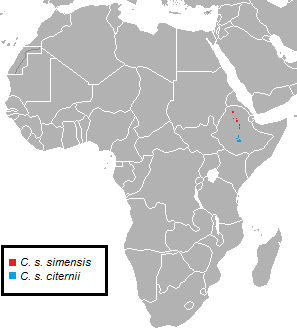Ethiopian wolf facts for kids
Quick facts for kids Ethiopian wolfTemporal range: Late Pleistocene - Recent
|
|
|---|---|
 |
|
| Ethiopian wolf on the Sanetti Plateau | |
| Conservation status | |
| Scientific classification | |
| Genus: |
Canis
|
| Species: |
simensis
|
 |
|
| Ethiopian wolf range | |
| Synonyms | |
|
|
The Ethiopian wolf (Canis simensis) is a special type of wild dog that lives in the Ethiopian Highlands. People also call it the Simien jackal or Simien fox. It looks a bit like a coyote in size.
This wolf has a long, narrow head and beautiful red and white fur. It mainly eats small rodents that live in the African mountains. The Ethiopian wolf only lives in high mountain ranges and at high altitudes. It is one of the rarest wild dogs in the world. It is also Africa's most endangered meat-eating animal.
The Ethiopian wolf faces many dangers. Its biggest threats are more people living in its areas and losing its home. This happens because of too much grazing by farm animals. Diseases from dogs and even interbreeding with dogs also threaten these wolves.
Contents
Where Ethiopian Wolves Live
Ethiopian wolves live only in the high mountains of Ethiopia. These areas are called the Ethiopian Highlands. They need very specific places to live. These places are usually above 3,000 meters (about 9,800 feet) in height.
They prefer open areas like grasslands and moorlands. These habitats are perfect for finding their main food source. The wolves need these high-altitude environments to survive.
What Ethiopian Wolves Eat
Ethiopian wolves are very picky eaters. Their diet is mostly made up of small rodents. These rodents live in the same high mountain areas as the wolves.
One of their favorite foods is the Big-headed mole rat (Tachyoryctes macrocephalus). These wolves are very good at hunting these small animals. They often pounce on them from above.
Why Ethiopian Wolves Are Endangered
The Ethiopian wolf is in danger of disappearing forever. There are only a few hundred of them left. Many things are causing their numbers to drop.
One big problem is that humans are moving into their habitat. This means less space for the wolves to live and hunt. Farm animals also eat the grass the wolves need.
Diseases from domestic dogs are another major threat. These diseases can spread quickly through wolf groups. Sometimes, wolves also breed with dogs, which can weaken the wolf population.
Images for kids
-
Ethiopian wolves resting near grazing zebu cattle.
See also
 In Spanish: Lobo etíope para niños
In Spanish: Lobo etíope para niños












